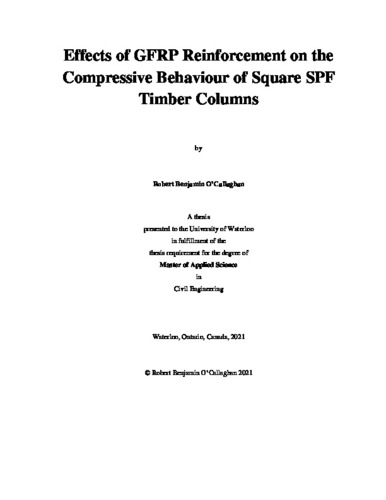| dc.contributor.author | O'Callaghan, Robert | |
| dc.date.accessioned | 2021-09-22 20:23:42 (GMT) | |
| dc.date.available | 2021-09-22 20:23:42 (GMT) | |
| dc.date.issued | 2021-09-22 | |
| dc.date.submitted | 2021-09-16 | |
| dc.identifier.uri | http://hdl.handle.net/10012/17479 | |
| dc.description.abstract | Wood structural elements are gaining popularity of use through greater availability of engineered wood products and a more sustainability focused construction industry. Stringent modern codes and extreme load cases (e.g., blast, impact) have prompted efforts to improve the performance of wood structural elements through rehabilitation and retrofit using fibre-reinforced polymer (FRP) composites. Previous research has primarily focused on improving the flexural performance leading to the investigation of reinforcement arrangements where elements are wrapped by transverse composites, which also reinforces the compression zone. On the other hand, research into the material behaviour of wood under parallel-to-grain compression as reinforced by transverse FRP composites is sparse.
Therefore this study is undertaken in order to test unreinforced and reinforced wood specimens under static compression loading parallel-to-grain up to large strains, to establish the material behaviour. Varying orientations and thicknesses of glass FRP (GFRP) composites were applied to investigate the effects of fibre angle and reinforcement quantity on the behaviour of the timber specimens. An experimental program investigating the behaviour of thirty-six 140 × 140 × 685 mm Spruce-Pine-Fir (SPF) No. 2 column specimens was developed where thirty specimens were reinforced with transverse-oriented GFRP composites on the full length of the specimen.
The results found reinforcement provided by GFRP composites improved the peak strength, and stiffness. Major improvements were seen in post-peak behaviour where reinforced specimens retained greater strength to higher strains. Failure modes involving longitudinal splitting were eliminated amongst reinforced specimens, and the damage was localized to a small area of wood characterized by wood fibre crushing. The thinnest reinforcement arrangements provided least improvement; samples with other arrangements performed similarly on average despite increasing thickness, regardless of glass fibre orientation. The ability of the GFRP composites to remain relatively intact and bonded to the wood specimen appears to be critical in strength retention and superior post-peak behaviour as well as in localizing damage. Effectively reinforced specimens behave as though comprised of clear wood rather than wood with defects present. | en |
| dc.language.iso | en | en |
| dc.publisher | University of Waterloo | en |
| dc.subject | wood | en |
| dc.subject | compression | en |
| dc.subject | frp | en |
| dc.subject | gfrp | en |
| dc.subject | passive confinement | en |
| dc.title | Effects of GFRP Reinforcement on the Compressive Behaviour of Square SPF Timber Columns | en |
| dc.type | Master Thesis | en |
| dc.pending | false | |
| uws-etd.degree.department | Civil and Environmental Engineering | en |
| uws-etd.degree.discipline | Civil Engineering | en |
| uws-etd.degree.grantor | University of Waterloo | en |
| uws-etd.degree | Master of Applied Science | en |
| uws-etd.embargo.terms | 0 | en |
| uws.contributor.advisor | Lacroix, Daniel | |
| uws.contributor.advisor | Kim, Kunho Eugene | |
| uws.contributor.affiliation1 | Faculty of Engineering | en |
| uws.published.city | Waterloo | en |
| uws.published.country | Canada | en |
| uws.published.province | Ontario | en |
| uws.typeOfResource | Text | en |
| uws.peerReviewStatus | Unreviewed | en |
| uws.scholarLevel | Graduate | en |

